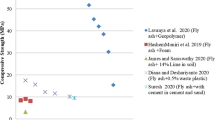Abstract
The conventional burnt clay bricks are usually employed for constructional purposes. However, there is another type of bricks called fly ash bricks that can also be broadly employed in all such works. When compared on the basis of weight and substantiality, this variety of brick is relatively better than the conventional bricks. Its application as chief crude material in the brick manufacturing will formulate adequate possibilities for its strait-laced and beneficial disposal and additionally support in environmental deterioration check to a vaster scope in the neighbouring regions of power manufactories as fly ash is being stockpiled as a rubbish element in great abundance around such power manufactories and producing severe environmental deterioration predicaments. The severe predicaments posed by brick manufacturers inflate unwanted outcomes such as soil erosion, deforestation, unwanted gas exhaustion, etc. As per statistics, 5000 acres of the uppermost cover of soil which formulate around 340 billion tones of clay is emptied out for bricks production, and annually we are able to employ 180 billion tonnes of conventional bricks. Therefore, such environmental predicaments can be subdued to a certain degree if fly ash bricks are employed for constructional purposes in place of conventional bricks and a lot of top covers can be conserved. This study aimed to interpret knowledge concerning about fly ash as a raw material in brick manufacturing and thereby establish and characterize its performances in an usual economical manner.
Access this chapter
Tax calculation will be finalised at checkout
Purchases are for personal use only
Similar content being viewed by others
References
Bhanumathidas, N., Kalidas, N.: Fly ash: the resource for construction industry. Indian Concr. J. pp. 997–1004 (2003)
Dhadse, S., Kumari, P., Bhagia, L.J.: Fly ash characterization, utilization and government initiatives in India—a review. J. Sci. Ind. Res. 67, 11–18 (2008)
Malaviya, S.K., Chatterjee, B., Singh, K.K.: Fly ash—an emerging alternative building material. Nat. Metall. Lab. Jamshedpur, 59–67 (2013)
Fly ash bricks masonry: an experimental study. Nat. Conf. Recent Trends Eng. Technol (2014)
IS 3495: Method of Testing of Burnt Clay Building Bricks (Part 1): Determination of Compressive Strength (Part 2): 1992 Determination of Water Absorption (Part 3):1992 Determination of Effloration (1992)
Indian Standard Referred
IS 12894: Pulverised fuel ash-lime bricks—specification (first Revision) (2002)
IS 3812: Pulverised fuel ash—specification (Part 1): for use as pozzolana in cement, Cement Mortar and Concrete, (Part 2): 2003 For use as Admixture in Cement Mortar and Concrete (2003)
IS 456: Plain And Reinforced Concrete—Code Of Practice (Fourth Revision) (2000)
Author information
Authors and Affiliations
Corresponding author
Editor information
Editors and Affiliations
Rights and permissions
Copyright information
© 2019 Springer Nature Singapore Pte Ltd.
About this paper
Cite this paper
Sharma, A.K., Kumar, S., Mishra, N. (2019). Environmental Impact of Fly Ash Brick in Comparison with Traditional Brick. In: Kolhe, M., Labhasetwar, P., Suryawanshi, H. (eds) Smart Technologies for Energy, Environment and Sustainable Development. Lecture Notes on Multidisciplinary Industrial Engineering. Springer, Singapore. https://doi.org/10.1007/978-981-13-6148-7_21
Download citation
DOI: https://doi.org/10.1007/978-981-13-6148-7_21
Published:
Publisher Name: Springer, Singapore
Print ISBN: 978-981-13-6147-0
Online ISBN: 978-981-13-6148-7
eBook Packages: EnergyEnergy (R0)




